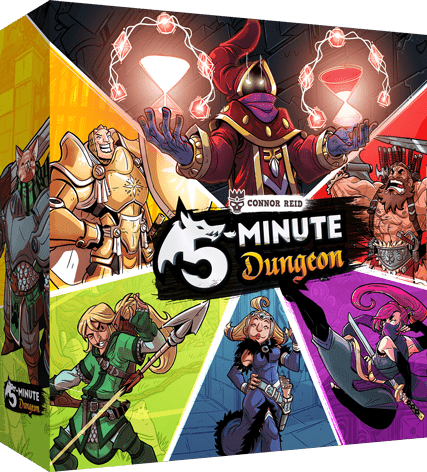There’s nothing I love more than introducing someone to board games—especially when I get to show them that modern games go far beyond Monopoly and Scrabble. The right gateway game can completely change someone’s idea of what a board game can be.
Over the years, I’ve found a handful of go-to games that are perfect for teaching. These games are easy to learn, fun to play, and consistently leave people wanting more.
Whether you’re teaching friends, family, or first-time players, here are four games that I always recommend.
⏱️ 1. 5-Minute Dungeon
Genre: Real-time cooperative chaos
Player Count: 2–5
Play Time: ~5 minutes per round
If I need to break the ice, this is the game I reach for. In 5-Minute Dungeon, players team up to defeat a deck of monsters, traps, and bosses in real time—using cards, teamwork, and sheer speed.
Why I Love Teaching It:
-
The rules are short and simple
-
Everyone plays at the same time—no waiting around
-
It’s pure, high-energy fun that gets people immediately engaged
📝 Teaching Tip:
Run a quick sample encounter with open hands so players can see how to match icons. Then press start on the timer and let the chaos begin!
🏰 2. Carcassonne
Genre: Tile-laying, area control
Player Count: 2–5 (best at 3–4)
Play Time: 35–45 minutes
Carcassonne is calm and strategic. Players take turns placing square tiles to build roads, cities, and monasteries—and then use meeples to claim and score those features.
Why I Love Teaching It:
-
Each turn is quick and intuitive
-
The growing board gives players a clear sense of progress
-
It introduces important mechanics like area control and timing
📝 Teaching Tip:
Skip the farmers for new players—just focus on cities, roads, and cloisters. Once players understand the basics, you can bring in the full scoring system.
💎 3. Splendor
Genre: Engine-building, resource management
Player Count: 2–4
Play Time: 30–40 minutes
In Splendor, players collect gem tokens and use them to purchase cards that make future purchases cheaper and eventually earn prestige points. It’s elegant and highly satisfying.
Why I Love Teaching It:
-
Simple rules, but strategic depth
-
The poker chip-style tokens are incredibly tactile and fun
-
It teaches planning and resource management in a very accessible way
📝 Teaching Tip:
Highlight how permanent gem cards reduce costs over time. Players tend to grasp the strategy once they’ve made a few purchases.
🐦 4. Perch (Inside Up Games)
Genre: Area majority, tactical
Player Count: 2–5
Play Time: 30–45 minutes
This one’s a newer favourite, and it’s quickly become one of my top picks. In Perch, you’re trying to dominate different tree tiles with your flock of birds—but here’s the twist: you place not only your birds, but also your opponents’.
Why I Love Teaching It:
-
The “play other players’ pieces” twist always blows people’s minds
-
Some trees score second or third place more than first—so it’s not all about domination
-
The modular tree board and special creature powers make every game feel different
📝 Teaching Tip:
Walk players through one scoring tile so they understand how points are awarded. Let them talk through their strategy in the first round .
✅ What Makes These Games Great for Teaching?
All four of these games are different in theme and mechanics, but they have some key traits in common:
-
Easy to learn — You can explain most of them in 5–10 minutes
-
Engaging right away — New players are drawn in from the first round
-
High interaction — Whether it’s cooperation, competition, they get people involved
-
Replayable — Each game stays fresh with variety, modularity, or evolving strategies

